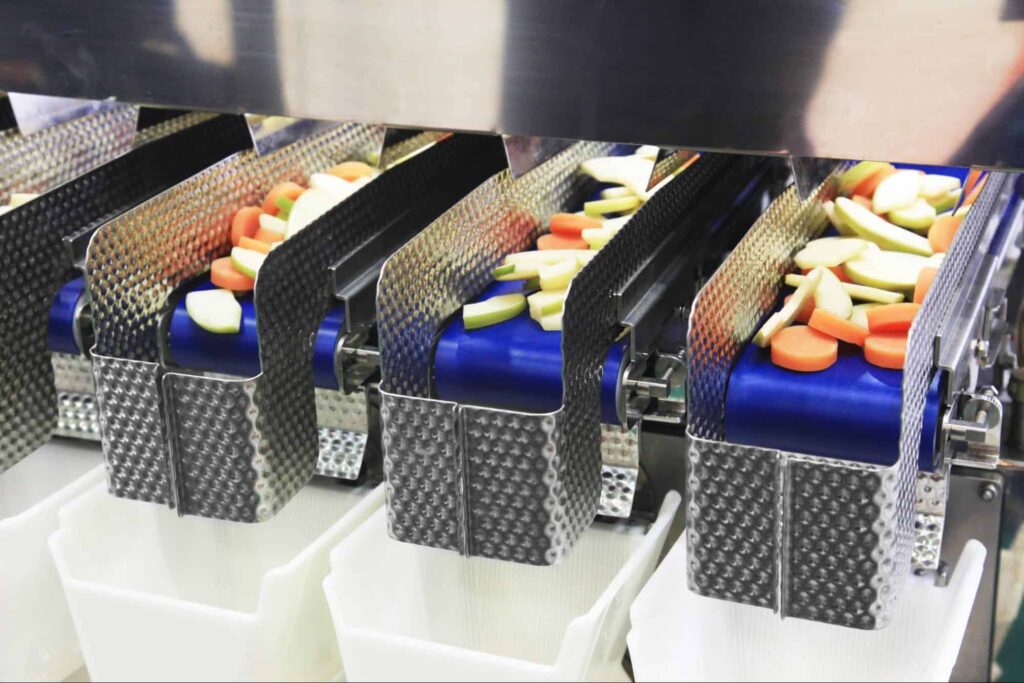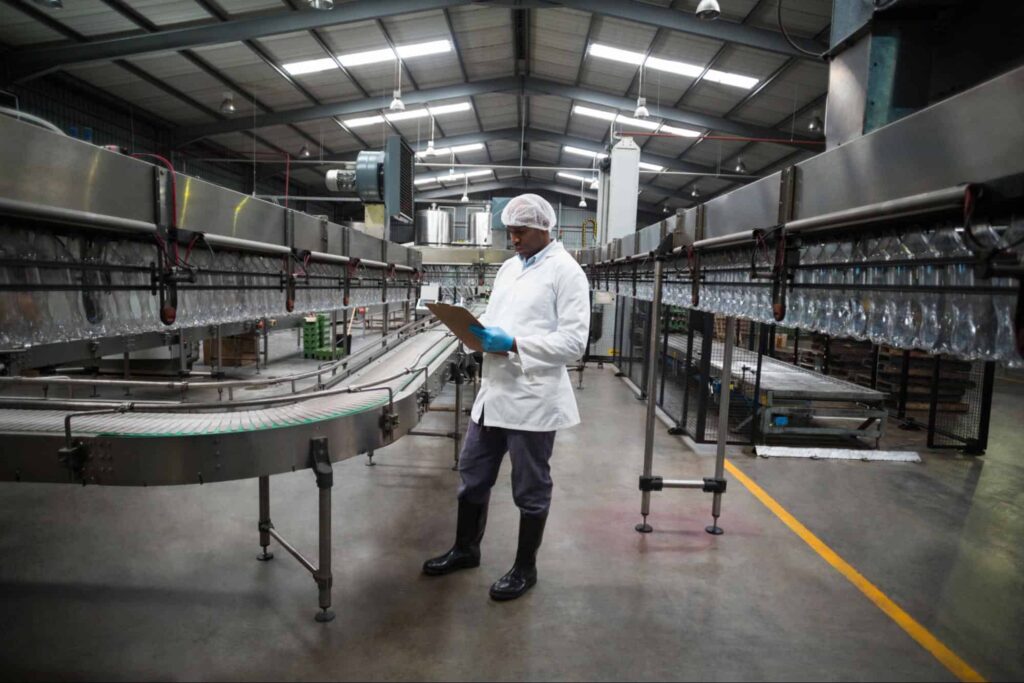Automated conveyor systems are a critical part of many industries, revolutionizing the way goods are moved, sorted, and processed within facilities. These systems utilize mechanized belts, rollers, or other modes of transportation to autonomously move items from one location to another, often within a factory or warehouse setting. By minimizing human involvement, they significantly reduce labor costs, increase efficiency, and decrease the possibility of human error.
The Global Food Industry Trends
According to Statista, the global food industry will be valued at around $8.77 trillion in 2022. The largest segment of the industry is the Confectionery & Snacks segment, valued at $1.53 trillion, followed by the Bread & Cereal Products segment, valued at $1.20 trillion.
Food processing is a huge and complex industry that involves many different types of businesses, from small family-run operations to large multinational corporations. One common denominator among all food processors, however, is the need to move food products efficiently and safely from one stage of production to the next. This is where conveyor systems come in.

Why Consider Automated Conveyor Systems
Conveyor systems are extensively used in the food processing industry – from transporting raw ingredients to packaging finished products. They come in all sizes and shapes and can be as simple or as complex as the operation needs them to be. In recent years, there has been an increasing trend toward automation in food processing, and conveyor systems are no exception.
In this comprehensive guide to automated conveyor systems in food processing, we aim to provide food processors with everything they need to know about automated conveyors, from what makes them tick to how to choose the best provider of automated conveyors.
Automation Principle in Material Handling
Let’s start with defining what automation is and how it impacts material handling solutions.
The College Industry Council on Material Handling Education (CICMHE) developed ten principles of material handling, one of which is automation. The definition of automation, according to CICMHE, is “the use of mechanized equipment and integrated systems to perform material handling functions with minimal or no human involvement.”
Applying this principle to conveyor systems, we can say that an automated conveyor system is a system that uses mechanized equipment to move materials with little or no human involvement. There are many different types of automated conveyor systems, but they all share the common goal of reducing or eliminating the need for manual labor in material handling. But why would anyone want to automate their conveyor system? Why do we need to reduce or eliminate manual labor? There are several reasons.

Benefits of Automated Conveyors
In the past, before the advent of modern bulk material handling equipment, food processing was a much slower and more labor-intensive process. Food processors had to rely on manual labor to move materials from one stage of production to the next. This was not only time-consuming, but it was also inefficient and often resulted in errors.
The most notable negative consequences of manual labor were product contamination and workplace injuries. Product contamination often occurs when workers come into contact with food products, either by accident or on purpose. This was a major problem in the food industry, as it posed a serious health hazard to consumers.
Workplace injuries were also common in manual material handling operations. As a result, worker turnover was high, and productivity was low. Manually operated conveyor systems helped speed up the process and reduce errors, but they still required a large workforce. Automated conveyor systems take things one step further by eliminating the need for manual labor altogether. There are many benefits of automated conveyor systems, including but not limited to increased workplace safety, better food sanitation, and higher quality of the product.
We already mentioned how workplace injuries were a major problem in the food industry before the advent of automated conveyors. By eliminating the need for manual labor, automated conveyor systems help to create a safer workplace environment. Your employees will no longer be exposed to the risk of injury from repetitive motion, lifting heavy loads, or coming into contact with food products.
One of the major issues with manual material handling is product contamination. Contamination is a serious problem in the food industry, as it can lead to foodborne illness. The good news is that the chances of food contamination are significantly reduced with automated conveyor systems. Since there is little to no manual labor involved, there is less opportunity for workers to come into contact with food products.
In addition, automated conveyor systems can be equipped with sensors that detect contaminants and remove them from the product stream. This helps to further reduce the risk of food contamination. Automated conveyor systems can also help to improve food safety by reducing the chances of cross-contamination. For example, if you are conveying raw food and cooked food on the same conveyor belt, there is a risk of cross-contamination if the belt is not properly cleaned between batches. However, if you use two separate conveyor belts for raw and cooked food, there is no risk of cross-contamination.
Relying on human labor for material handling can often lead to errors and inconsistencies. Automated conveyor systems help to eliminate these problems by providing a consistent and accurate method of handling materials. As a result, you can expect a higher quality product when you use an automated conveyor system. Adhering to various quality standards is also easier, as you can program the conveyor to meet your specific requirements.
The consistent movement of materials also helps to reduce the chances of damage. For example, if you are conveying fragile items, they are less likely to be damaged if they are not being handled by humans (and are being handled by the right type of conveyor, depending on the material characteristics).
Automation conveyor systems are more efficient than manually operated systems, as they can handle a larger volume of materials in a shorter period of time. This is because automated conveyor systems can work at a higher speed and with greater precision than humans.
In addition, automated conveyor systems free up your workers to perform other tasks, which helps to improve productivity. For example, suppose you are using a conveyor to transport raw materials to a packaging station. In that case, your workers can be performing other tasks, such as quality control or product assembly, while the conveyor is running. This helps to improve the overall efficiency of your food processing operation.
Finally, one of the biggest advantages of automated conveyor systems is that they can help to reduce your operating costs. The initial cost of the industrial conveyor belt system may be higher than a manually operated system, but you will see a return on your investment over time.
The reduced reliance on manual labor can help to reduce your labor costs, while the increased efficiency can help to reduce your energy costs. In addition, automated conveyor systems can run for a lot longer than manual systems, which means that you will not need to pause production as often or for long periods of time.
Automated Features
What makes a conveyor system automated? What aspects of material transfer can be automated? There are many different automated features that can be added to a conveyor system. The specific features will depend on the application and the needs of your food processing operation.
Loading and Unloading
The loading and unloading of materials onto a conveyor belt can be automated using various methods, such as:
- Bulk loaders – these are used to load large volumes of materials onto the conveyor in a quick and efficient manner.
- Vacuum loaders – these use suction to pick up small items and load them onto the conveyor.
- Row-forming loaders – these are used to load materials that need to be arranged in a specific way (such as products that need to be packaged in a row).
Automatic loaders and unloaders can be programmed to load or unload materials at specific intervals, which helps to keep the conveyor running smoothly and at a consistent speed.
Sorting Feature
Sorting can be performed according to various criteria, such as product type, destination, or order. If you need to sort materials as they are being conveyed, this can also be automated using various sortation systems, shown in the table below.
| Sortation Type | Description |
| Pusher sortation | This uses a series of paddles to push products off the conveyor and into chutes that lead to different destinations. |
| Pop-up wheel sortation | This uses a series of rotating wheels to divert products off the conveyor and into chutes that lead to different destinations. |
| Cross-belt sortation | This uses a series of belts that run perpendicular to the main conveyor belt to divert products off the conveyor and into chutes that lead to different destinations. |
Labeling and Packaging
If you need to label or package products as they are being conveyed, this can also be automated using various equipment, such as:
- Labeling machines – these apply labels to products as they pass by on the conveyor.
- Packaging machines – these place products into packages and seal the packages shut.
Conveyors themselves don’t have the capacity to label or package, but these processes can also be automated when used in conjunction with the proper equipment.
Automated Cleaning and Maintenance
This won’t always be the case, but some automated industrial conveyor systems come with features that make cleaning and maintenance easier. For example, nowadays, you can have conveyors with clean-in-place mechanisms. These are used to clean the conveyor without having to disassemble the entire system.
When it comes to maintenance, some automated conveyor systems come with condition-based monitoring. This means that the system is constantly monitoring itself for any potential issues. If a problem is detected, a message is sent to the maintenance team so that they can fix the issue before it becomes a bigger problem.
Conveying Controls
When it comes to conveyor automation, one of the most important aspects is the conveyor control system. This is what allows you to operate your conveyor in an automated fashion. There are many different types of conveyor controls on the market, so it’s important to choose one that is compatible with your specific needs. Some of the most common features that you’ll find in a conveyor control system include:
- Start/stop controls – these allow you to start and stop the conveyor as needed.
- Speed controls – these allow you to adjust the speed of the conveyor belt.
- Directional controls – these allow you to change the direction that the conveyor belt is moving.
- Sorting controls – these allow you to control the sorting process.
- Labeling and packaging controls – these allow you to control the labeling and packaging process.
Conveyor controls can be operated manually or automatically. If you choose an automated system, you’ll need to program the controls to act according to your specific needs.
Performance Data
Another significant aspect of conveyor automation is performance data. This is the information gathered by the conveyor control system to track the performance of the conveyor solution. Performance data can troubleshoot problems, optimize performance, and make sure that the conveyor is running as efficiently as possible. When it comes to conveyor automation, performance data is essential in order to ensure that the system is running smoothly. Some of the most common types of performance data that you’ll find are shown in the table below.
| Measurement Factor | Description |
| Conveyor speed | This is the speed at which the conveyor belt is moving. |
| Product throughput | This is the number of products that are being conveyed per minute. |
| Conveyor utilization | This is the percentage of time that the conveyor is actually conveying products. |
Finding the Best Provider of Automated Conveyor Systems
If you’re interested in getting an automated conveyor system for your food processing facility, it’s important to find a reputable and experienced provider. There are many different providers on the market, so it’s important to do your research to find the best one for your specific needs. Here are a few tips to help you find the best provider of automated conveyor systems.
Decide on the Conveyor Type You Need
It may seem obvious, but not all conveyor manufacturers offer the same type of conveyor. Some specialize in the production of a belt conveyor system, while others provide screw augers, chain conveyor systems, pneumatic conveyor systems, bucket elevators, tubular cable and disc conveyors, or other types of conveyors.
So, before you start looking for a provider, it’s important to decide on the kind of conveyor you need. This will help you narrow down your options and find a provider that specializes in the type of conveyor you need. For example, if you’re transporting nuts, snack food, breakfast cereals, pet food, or coffee beans, a tubular cable and disc conveyor such as those that Cablevey Conveyors offers would be a good option.
Ask the Right Questions
When you put together a list of potential providers, don’t hesitate to get in touch with them as soon as possible. This will give you a chance to ask any questions that you may have about their products and services. Some of the most important questions to ask include:
- What type of conveyor and controls work best for the kind of material you want to convey?
- Is there a chance to do material testing before committing to anything?
- How easy is it to maintain their systems?
- What is their lead time for an order of your size (or similar)?
- What are their service agreements and support like?
- How fast can you get a quote?
Don’t forget to ask about the warranty as well. It’s important to find a provider that offers a good warranty in case anything goes wrong with the conveyor. These questions will help you better understand the provider and its products.
Get Multiple Quotes
Don’t just go with the first quote you receive. It’s important to get multiple quotes from different providers so that you can compare prices and find the best deal. When requesting quotes, provide as much detail about your project as possible. This will help the provider give you a more accurate quote. It would be best to ask for quotes for both the conveyor and the controls. Many providers offer package deals, but it’s important to compare prices before deciding.
Research Thoroughly
The simple act of googling “automated conveyor systems” can give you a good starting point for your research. But don’t stop there – take some time to read reviews, case studies, and blog posts about the different providers on your list. This will help you better understand their products, services, and overall reputation in the industry. Asking for recommendations from other food processing facilities is also a good idea. If you know anyone who has recently installed an automated conveying system, ask them about their experience and whether or not they would recommend the provider they used.
Take Your Time
Don’t rush into anything. The decision to install an automated conveyor system is a big one, so it’s important to take your time and find the best provider for your specific needs. By following these tips, you should be able to find a reputable provider of automated conveyor systems that can help you streamline your food processing operation.

Reach Out to Cablevey Conveyors and Implement Your Own Conveyor Belt for Food
The times of manually operated conveyor systems are ancient history – today’s facilities for food processing require automated solutions that can keep up with the high demand. Some of the benefits of automation in food processing include increased efficiency, worker and food safety, and product quality.
When choosing a provider for your automated conveyor system or a custom conveyor belt for a warehouse, it’s important to do your research and ask the right questions. You should also get multiple quotes and take your time to make sure you’re making the best decision for your facility. If you’d like to learn more about our products and services, or if you have any questions, feel free to contact us at Cablevey Conveyors. We’d be happy to help you find the best solution for your needs.






